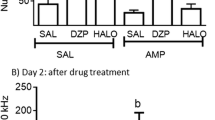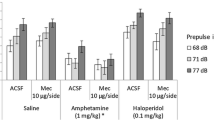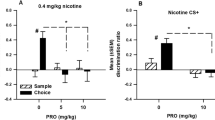Summary
In previous studies it was established that stereo-typies (sniffing, licking, gnawing) produced by apomorphine can be conditioned and after repeated pairings with defined conditioned stimuli (auditory, tactile + olfactory) these stereotypies can be observed in the presence of the conditioned stimuli alone. In the present experiments, the extinction of these conditioned stereotypies was studied in one series; in another series, the possible inhibition of conditioned stereotypies by the blocker of dopamine receptors, haloperidol, was measured. The rats were conditioned (or the controls pseudoconditioned, respectively) for either 3 or 10 days with 2.0 mg/kg s. c. apomorphine or 6 days with 0.5 mg/kg s. c. of the drug and by placing them into particular cages in the presence of an auditory and an olfactory stimulus. Under all these conditions, episodes of conditioned stereotypies were observed, when solvent + conditioned stimuli instead of apomorphine was applied 1 day after the last conditioning session (first session of extinction). The conditioned responses seemed to be on the highest level after conditioning with 2.0 mg/kg apomorphine 3 days, lower after conditioning with the same dose on 10 days, and even lower after conditioning for 6 days with 0.5 mg/kg. Under all these conditions, the stereotypies summed up and averaged for the total observation period of 60 min rapidly decreased during the extinction period, so that on day 4 of the extinction period, no further significant differences between conditioned and pseudoconditioned animals were observed, although a short initial period was still observed on the fourth day. On day 3 of extinction, not only an early, but also a late episode of conditioned stereotypies was manifest, interrupted by an almost silent period. The acute (unconditioned) stereotypies produced by 0.5 mg/kg s. c. apomorphine were almost completely suppressed by pre-treatment with 0.1 mg/kg i. p. haloperidol. In contrast, the same dose of haloperidol produced a much less pronounced inhibition of conditioned stereotypies after conditioning with the same dose of apomorphine for 6 times. These results, together with previous findings, suggest that the conditioned behavioural effects are not due to an activation of dopaminergic mechanisms during conditioning with apomorphine.
Similar content being viewed by others
References
Anden NE, Rubensson A, Fuxe K, Hökfelt T (1967) Evidence of dopamine receptor stimulation by apomorphine. J Pharm Pharmacol 19:627–629
Barr GA, Sharpless NS, Cooper S, Schiff SR, Paredes W, Bridger WH (1983) Classical conditioning, decay and extinction of cocaine-induced hyperactivity and stereotypy. Life Sci 33:1341–1352
Beninger RH, Hahn BL (1983) Pimozide blocks establishment but not expression of amphetamine-induced environment-specific conditioning. Science 220:1304–1306
Beninger RH, Herz RS (1986) Pimozide blocks establishment but not expression of cocaine-induced environment-specific conditioning. Life Sci 38:1425–1431
Burunat E, Diaz-Palarca MD, Castro R, Rodriguez M (1987) Undrugged rotational response in nigro-striatal system lesioned rats is related to the previous early response to apomorphine when repeatedly administered. Life Sci 41:309–313
Carey RJ (1986) Conditioned rotational behaviour in rats with unilateral 6-hydroxydopamine lesions of the substantia nigra. Brain Res 365:379–382
Costall B, Naylor RJ (1973) The role of telencephalic dopaminergic systems in the mediation of apomorphine-stereotyped behaviour. Eur J Pharmacol 24:8–24
Drew KL, Glick SD (1987) Classical conditioning of amphetamine-induced lateralized and non-lateralized activity in rats. Psychopharmacology 92:52–57
Ernst AM (1967) Mode of action of apomorphine and dexamphetamine in gnawing compulsion in rats. Psychopharmacology 10:316–323
Harnack E (1874) Über die Wirkungen des Apomorphins am Säugetier und am Frosch. Arch Exp Path Pharmakol 2:254–306
Havemann U, Kuschinsky K (1982) Neurochemical aspects of the opioid-induced “catatonia”. Neurochem International 4:199–215
Havemann U, Magnus B, Möller HG, Kuschinsky K (1986) Individual and morphological differences in the behavioural response to apomorphine in rats. Psychopharmacology 90:40–48
Iversen SD (1983) Brain endorphins and reward function: some thoughts and speculations. In: Smith JD (eds) The neurobiology of opiate reward processes. Elsevier Biomedical, Amsterdam, pp 439–468
Möller HG, Nowak K, Kuschinsky K (1987a) Conditioning of pre- and postsynaptic behavioural responses to the dopaminereceptor agonist apomorphine in rats. Psychopharmacology 91:50–55
Möller HG, Nowak K, Kuschinsky K (1987b) Studies on interactions between conditioned and unconditioned behavioural responses to apomorphine in rats. Naunyn-Schmiedeberg's Arch Pharmacol 335:673–679
Robbins TW (1976) Relationship between reward-enhancing and stereotypical effects of psychomotor stimulant drugs. Nature 264:57–59
Schiff SR (1982) Conditioned dopaminergic activity. Biol Psychiatry 17:135–154
Wikler A (1980) Opioid dependence: mechanism and treatment. Plenum Press, New York London, pp 167–218
Yokel RA (1987) Intravenous self-administration: response rates, the effects of pharmacological challenges, and drug preference. In: Bozarth MA (ed) Methods of assessing the reinforcing properties of abused drugs. Springer, New York Berlin Heidelberg London Paris Tokyo, pp 1–33
Author information
Authors and Affiliations
Additional information
Send offprint requests to K. Kuschinsky at the above address
Rights and permissions
About this article
Cite this article
Welsch-Kunze, S., Nowak, K. & Kuschinsky, K. Conditioned behavioural responses to apomorphine: extinction and haloperidol-induced inhibition. Naunyn-Schmiedeberg's Arch Pharmacol 338, 671–677 (1988). https://doi.org/10.1007/BF00165633
Received:
Accepted:
Issue Date:
DOI: https://doi.org/10.1007/BF00165633




